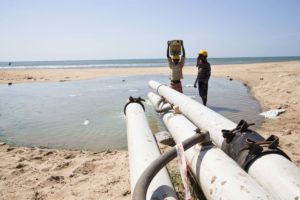Infrastructural urbanism: assembling the techno-political city | Niranjana Ramesh

In the third Monsoon Assemblages seminar, Niranjana Ramesh, PhD candidate at the department of Geography of UCL, London, presented parts of her on-going research comparing desalination plants, and their underpinning policies, in Chennai, India, and London, UK.
Of her thesis, titled “Techno-politics of urban water: the case for desalination in Chennai and London”, she mostly presented the case study of Chennai’s desalination plants.
Chennai’s “techno-politics of urban water” were broadly presented highlighting their multifaceted nature. The public discourse about water and its social construction in the media and in the political discourse, for instance, was exemplified through newspaper accounts and campaign posters. She then framed the development of Chennai’s urban water infrastructure, and of the political dynamics constructed around it, proposing an original interpretation of assemblage theory, which looked at both at the physical assemblages used to supply water in the city, and the political actors that water congregates around itself in the political arena.
Some specific questions emerged regarding the specific assemblages built around water in Chennai: how is water politicised, and which role technical knowledge plays in this politicisation? Is there a technical turn in this politicisation, and eventually why is it happening now? To which extent are considerations of a biological/political nature, and the foucauldian arguments coming with them, useful in order to unpack and analyse how everyday lives of Chennai inhabitants are shaped by assemblages of water supply?
In order to frame these questions, the presentation drew on a diverse range of critical theoretical work: namely the work on hydro-technical knowledge and state formation by Patrick Carroll, or that on the bio-politics of water by Karen Bakker.
Looking at Chennai’s context through this lens, made an interesting picture emerge. Water in Chennai appears to be conceived through a collective desire to control and tame it, evoking technical solutions as ways to combat a perceived uncertainty about precipitations. The researcher evoked Deleuze’s concept of machine désirante to draw a connection between how water is discussed in the public realm and how technical solutions to “solve” water supply issues enter the political debate.
Her multi-layered reading of Chennai’s water supply was reflected in the nimble adaptations of assemblage theory proposed in her research. She used water assemblages, in fact, not just as instruments to look at and interpret “phenomena of emergence”, but as compositions of elements that account for both the material agency of the single actors or objects being collected in them, and the purposefulness/intentionality of the assemblage itself.
For this reason, the concept of the assemblage is subjected in her work to a critical revision that aims at comparing it, and possibly integrating it, with other concepts: namely the concept of the “archipelago” used by Karen Bakker for Jakarta, or that of the “agencement” by Deleuze.
Finally, the “desire” for a technical solution to what is interpreted as water scarcity is aptly epitomised by looking at sea water desalination: possibly the most techno-scientific means to guarantee water supply – being completely disconnected from the local hydrology. The actual analysis of the decision-making process behind the construction of the desalination plants as well the complex institutional structure underpinning it, was supported by a conceptualisation of its assemblage inspired by Allen and Cochrane’s work, and mapped the relations between institutions, actors, vested interests and places behind the realisation of the desalination plant.
The discussion which followed the presentation revolved around several topics: the appropriateness of using assemblage theory when discussing institutional processes which, in most contexts, are interpreted as static and structured, rather than articulated and emergent; the difficulties of distinguishing between the scope of state agency and that of market agency, since they are often gathered in bundles in complex ways namely dubbed “extrastatecraft” by Keller Easterling; the opportunity of unearthing pre-existing assemblages built around water in the places where new policies are physically intervening, in order to understand how historical layers interfere and interact with new ones.
